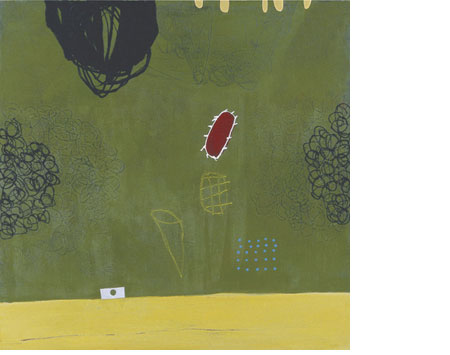
Vibratory permutations of color and balanced, intuitive compositions lend Silvia Poloto’s paintings a playful élan. The São Paolo-born, San Francisco-based artist was an engineer before she became an artist, and the attentiveness with which she arranges abstract forms betrays an engineer’s concern for structural integrity. In Observations in Green #4, for example, she anchors the composition with a beige field that functions as a horizon line and gives the piece the feel of an abstracted landscape. In Cream and Coal #2, she bisects the piece’s central circles with slabs of black and eggshell, imparting a stability that she wryly undermines with willy-nilly scrawls, which flank those circles and hover above them. This mode of contrasting structure with looseness is a conceit that spans the work, with Poloto counterbalancing geometric forms with graffito-like improvisations, solid shapes with outlines. Pentimenti peek up through the surfaces’ many layers, telegraphing an organicism beneath the flashy surfaces. Sometimes the artist employs resin to impart a gloss to those surfaces; in other pieces she incorporates collaged printed matter. With painterly topographies that are already deeply layered and richly textural, these tactics seem superfluous. The paintings are self-assured on their own and do not require extra bells and whistles.
Chromatically, the works are a riot of supersaturated orange backgrounds, blues, reds, sunflower yellows, and popping accents that would make Josef Albers proud. The white and blue shapes in Observations in Deep Orange #22 sear and sizzle; a raindrop-shaped form in Observations in Red #12 is outlined in a white so intense, it threatens to leave a sunspot afterimage on the retina. Across the work, Poloto displays a predilection for toying with formal elements, dialectically pitting dark, heavy forms against airy scribbles. There is a willfulness and obsession to these variations on a theme, yet the bold color palette imparts a buoyancy and fizz that keeps the works from devolving into fussiness, which they might assume in more introverted tones. As they are, the paintings integrate form and color into a brash, unified whole.
